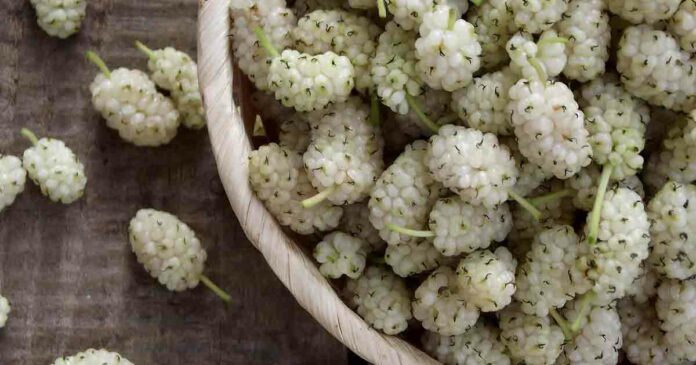Mulberry: Good for Silkworms, but May Benefit You as Well

Story at-a-glance
- Mulberry is a large, deciduous tree that produces small fruits similar to blackberries and raspberries. These fruits can be eaten as they are or used as an ingredient in pies, tarts, muffins, cakes, milkshakes, cocktails, jams, jellies and wine
- In some countries, mulberry leaves are primarily used as food for silkworms. They may also be brewed to make tea that may help manage high blood pressure or made into a decoction to help relieve throat inflammation
- Although small in size, mulberries were found to provide numerous beneficial effects for digestive health, blood circulation, organs and tissues, blood sugar level and liver health
Mulberry (Morus) is a large, deciduous tree that produces small fruits clumped together, similar to blackberry and raspberry.1 It’s estimated that there are over 100 different mulberry varieties and 24 Morus species, but these are the most common species:2,3
- White mulberry (Morus alba), which is native to eastern Asia
- Red mulberry (Morus rubra), which is native to northern America
- Black mulberry (Morus nigra), which is native to southwestern Asia
To help you distinguish mulberry variants, remember that they are identified by the color of their leaves, flowers and buds — not by the color of the berries, as it’s possible for a white mulberry tree to produce lavender or black mulberries.4
5 Health Benefits of Mulberry
Mulberry is rich in antioxidants and nutrients like potassium, calcium and magnesium,5 which are beneficial for metabolism.6 Studies have also found its potential benefits for the following areas:
- Digestive health — A 100-gram serving of mulberries can give you 1.7 grams of fiber.7 Dietary fibers may help improve overall digestive health by promoting regular bowel movement and lowering your risk of stomach diseases.8
- Blood circulation — Mulberry’s iron content9 may help boost the production of red blood cells, improving the distribution of oxygen to every cell in your body.10
- Organ and tissue health — Mulberry’s methanolic contents, which exhibit anti-inflammatory and antioxidant activities, may help reduce your risk of organ and tissue injury.11
- Blood sugar level — Mulberry contains a special antioxidant called DNJ (1-deoxynojirimycin) that helps inhibit the breakdown of carbohydrates into sugar. Since it helps lower the amount of sugar going into your system, it may be beneficial for diabetes management.12
- Liver health — According to one study, mulberry may help alleviate the buildup of fatty deposits around your liver, resulting in a lower risk of various hepatic diseases.13
What Are the Uses of Mulberry?
Aside from being eaten as it is, the mulberry fruit is used as an ingredient in making pies, tarts, muffins, cakes and milkshakes.14 It can also be pressed or pureed to make drinks and cocktails, preserved to make jams and jellies15 and fermented to make wine.16
The mulberry plant can be a herbal remedy as well. Its leaves may be used to make a decoction, which may be gargled to help relieve throat inflammation. Its root extract, as well as its leaves’ tips, may be brewed to make tea, which may help manage high blood pressure.17
In some countries, mulberry is primarily used as food for silkworms,18 making it an economically important plant for countries that heavily rely on silk production. In fact, it is the only food source of Bombyx mori L., the silkworm species that produces most of the world’s silk.19
To create the silk, eggs are kept in an enclosed environment with a temperature of 65 degrees Fahrenheit, which is gradually increased to 77 degrees Fahrenheit until they hatch. The worms are then fed with handpicked and chopped mulberry leaves until they gain weight and enter the cocoon stage.
From there, the silk that surrounds the cocoon is extracted by boiling the eggs. Five to eight filaments are then twisted to create a single silk thread. It’s estimated that 2,500 cocoons can produce a pound of raw silk.20
How to Grow Mulberry in Your Garden
Growing mulberries is generally a simple affair because they are easy to transplant, tolerant to salt and may even help with erosion control. You’ll need a sizeable garden because the trees can grow quite large. Mulberry trees can have varying heights, depending on their species. Black mulberry trees can reach up to 30 feet, red mulberry can grow up to 70 feet and white mulberry are the tallest at 80 feet.21 Here are the steps in planting a mulberry tree through propagation, according to SF Gate:22
- Cut 4- to 6-inch-long stems from a mature mulberry tree.
- Slice off the blooms, leaves and buds from the bottom half of the stems and dip an inch of their bottom parts in natural rooting hormone.
- Plant the stems in the soil with a depth of about one-third of their lengths and cover them with a clear plastic container for protection. Remember to keep the soil consistently moist and place the stems in a bright spot.
Below are several pictures of me harvesting mulberries from my back yard. I planted these a few yeas ago as a one foot stem and it has grown into three large 15 foot bushes that provide many gallons of mulberries every year. Delicious.
 |
 |
 |
Try This Nutritious Mulberry Recipe Today
Mulberry is naturally sweet with a mild flavor,23 making it an ideal ingredient in many desserts. If you’re looking for a quick and easy recipe using mulberries, try this refreshing mulberry papaya salad from “The Wild Vegan Cookbook:”24
Mulberry Papaya Salad
Ingredients
- 1 cup mulberries
- 2 medium-sized ripe papayas, peeled, seeded and diced
- 2 tablespoons natural cherry juice or other fruit juice
- 1 cup hazelnuts, chopped
- 2 teaspoons ground cinnamon
- 2 teaspoons dried mint, finely crumbled
- 1/2 teaspoon liquid stevia or 2 tablespoons raw honey
Procedure
- Mix together all the ingredients in a medium-sized serving bowl.
- Chill and serve.
How to Make Mulberry Oil Infusion
Mulberry leaves produce a unique essential oil, which makes silkworms attracted to this plant.25 This essential oil can also be used as an ingredient for home and personal care products such as:26
- Soaps
- Hand and body lotions
- Candles
- Shampoos
To obtain the fragrance of mulberry, you will need to infuse its leaves in a carrier oil. Coconut oil is a great carrier oil because it has a very mild scent, and offers its own health benefits like thyroid function boost,27 skin hydration28 and healthy metabolism.29 Follow these steps in making your own mulberry oil infusion, courtesy of DIY Natural:30
- Place a hand towel at the bottom of your slow cooker to prevent heat from directly touching the jars, and then fill the container half-full with water. Turn on the cooker to a “warm” setting.
- Gently rub the mulberries between your hands, and then fill up a Mason jar with the fruits to about one-third to one-half. Cover the fruits with enough coconut oil and leave at least 1 inch of headspace from the cover, and then stir the mixture to release air bubbles.
- Cover the jar then place it into the slow cooker. Allow it to infuse for eight to 12 hours on the lowest setting. Stir and shake the jar occasionally during the process.
- Allow the mixture to cool down, and then strain the oil into a new jar.
- Label the final product accordingly.
Sources and References
- 1 “Plant Foods for Nutritional Good Health,” 2019
- 2 Int. J. Mol. Sci. 2019;20(2):301
- 3 “Encyclopedia of Cultivated Plants: From Acacia to Zinnia [3 volumes]: From Acacia to Zinnia,” 2013
- 4 “Wild Crop Relatives: Genomic and Breeding Resources: Tropical and Subtropical Fruits,’ 2011
- 5 J Zhejiang Univ Sci B. 2010 Dec;11(12):973-80
- 6 International Journal of Food Sciences and Nutrition. 2009;60(3):231-239
- 7, 9 USDA National Nutrient Database, “Basic Report: 09190, Mulberries, raw”
- 8 Mayo Clinic, November 16, 2018
- 10 Mayo Clinic, “Iron Deficiency Anemia”
- 11 Fitoterapia. 2005 Dec;76(7-8):608-13
- 12 J Agric Food Chem. 2001 Sep;49(9):4208-13
- 13 J Sci Food Agric. 2011 Dec;91(15):2740-8
- 14, 18 “North American Cornucopia: Top 100 Indigenous Food Plants,” 2013
- 15 “The Illustrated Cook’s Book of Ingredients: 2,500 of the World’s Best with Classic Recipes,” 2010
- 16 “Wild Wines: Creating Organic Wines from Nature’s Garden,” 2006
- 17 “Mulberry for Animal Production: Proceedings of an Electronic Conference Carried Out Between May and August 2000,” 2002
- 19 Central Silk Board, “Mulberry Silk”
- 20 Silk Road, “Silk Production”
- 21 Gardening Know How, April 4, 2018
- 22 SFGate, “How to Start Growing a Mulberry Tree From Another Tree”
- 23 “The Blue Chair Jam Cookbook,” 2010
- 24 “The Wild Vegan Cookbook,” 2010
- 25 “Aromatherapy Science: A Guide for Healthcare Professionals,” 2006
- 26 Stylecraze, “November 27, 2018
- 27 “Coconut Oil Handbook: Benefit From Coconut Oil’s Healing Powers for Beauty and Health, Weight Loss, Detoxification, and Metabolism,” 2014
- 28 Dermatitis. 2004 Sep;15(3):109-16
- 29 “The Coconut Oil Miracle,” 2004
- 30 DIY Natural, “How to Make an Easy Herbal Oil Infusion”

